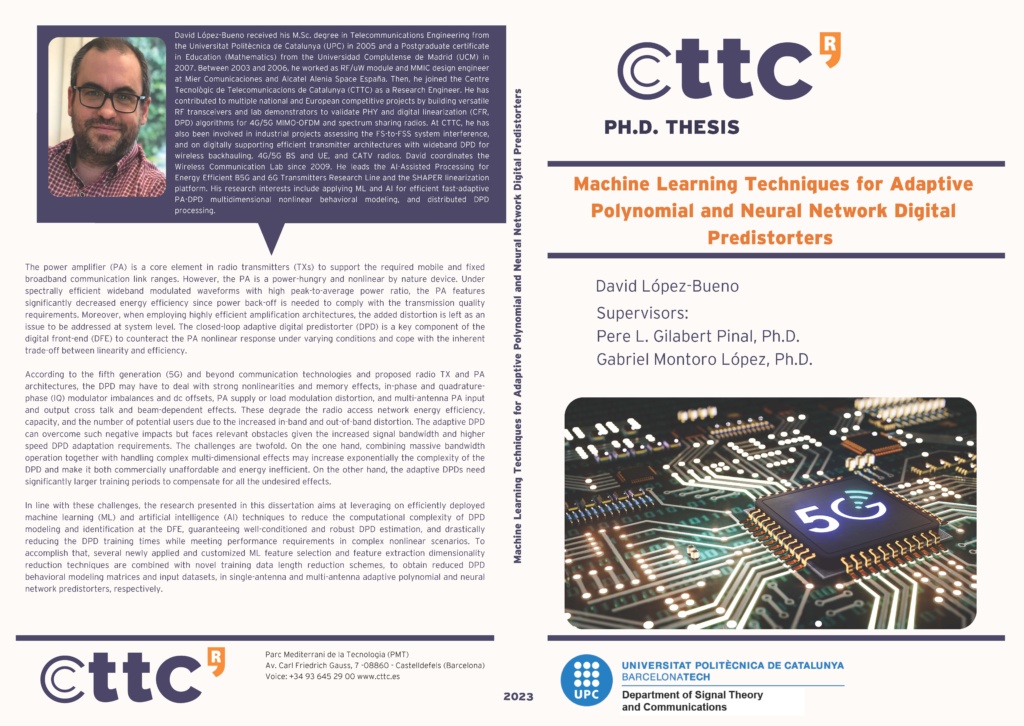
Machine Learning Techniques for Adaptive Polynomial and Neural Network Digital Predistorters
Author/Autor: Dr. David López-Bueno
Year/Any: 2023
ABSTRACT
The power amplifier (PA) is a core element in radio transmitters (TXs) to support the required mobile and fixed broadband communication link ranges. However, the PA is a power-hungry and nonlinear by nature device. Under spectrally efficient wideband modulated waveforms with high peak-to-average power ratio, the PA features significantly decreased energy efficiency since power back-off is needed to comply with the transmission quality requirements. Moreover, when employing highly efficient amplification architectures, the added distortion is left as an issue to be addressed at system level. The closed-loop adaptive digital predistorter (DPD) is a key component of the digital front-end (DFE) to counteract the PA nonlinear response under varying conditions and cope with the inherent trade-off between linearity and efficiency.
According to the fifth generation (5G) and beyond communication technologies and proposed radio TX and PA architectures, the DPD may have to deal with strong nonlinearities and memory effects, in-phase and quadrature-phase (IQ) modulator imbalances and dc offsets, PA supply or load modulation distortion, and multi-antenna PA input and output cross talk and beam-dependent effects. These degrade the radio access network energy efficiency, capacity, and the number of potential users due to the increased in-band and out-of-band distortion. The adaptive DPD can overcome such negative impacts but faces relevant obstacles given the increased signal bandwidth and higher speed DPD adaptation requirements. The challenges are twofold. On the one hand, combining massive bandwidth operation together with handling complex multi-dimensional effects may increase exponentially the complexity of the DPD and make it both commercially unaffordable and energy inefficient. On the other hand, the adaptive DPDs need significantly larger training periods to compensate for all the undesired effects. In line with these challenges, the research presented in this dissertation aims at leveraging on efficiently deployed machine learning (ML) and artificial intelligence (AI) techniques to reduce the computational complexity of DPD modeling and identification at the DFE, guaranteeing well-conditioned and robust DPD estimation, and drastically reducing the DPD training times while meeting performance requirements in complex nonlinear scenarios. To accomplish that, several newly applied and customized ML feature selection and feature extraction dimensionality reduction techniques are combined with novel training data length reduction schemes, to obtain reduced DPD behavioral modeling matrices and input datasets, in single-antenna and multi-antenna adaptive polynomial and neural network predistorters, respectively.
RESUM
L’amplificador de potència (PA) és un element central als radiotransmissors necessari per abastar les distàncies d’enllaç a les comunicacions sense fils de banda ampla mòbil i fixa. No obstant, el PA és un dispositiu d’elevat consum energètic i de comportament no lineal per naturalesa. Quan s’utilitzen formes d’ona de banda ampla i gran eficiència espectral que presenten elevada relació de potència de pic a potència mitjana, l’eficiència energètica del PA decreix significativament atès que és necessari operar el dispositiu amb un marge de guarda per complir amb els requisits de qualitat de transmissió. Addicionalment, quan s’utilitzen arquitectures d’amplificació altament eficients basades en PAs de tipus Doherty, modulació de càrrega d’amplificador balancejat (LMBA) o modulació d’envoltant (ET), la distorsió afegida es deixa com un problema a resoldre a nivell de sistema per un linealitzador.
En aquest context, el predistorsionador digital (DPD) adaptatiu de llaç tancat és un element clau del capçal digital de processament ràdio (DFE) per contrarestar la resposta no lineal del PA en condicions variables i superar el compromís inherent entre linealitat i eficiència.
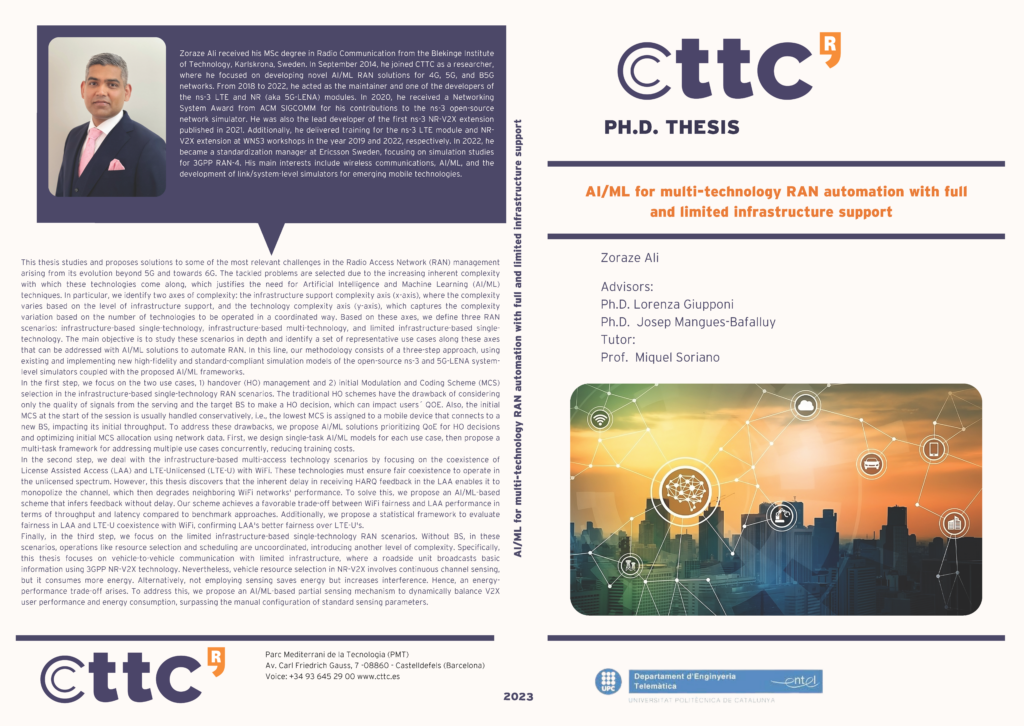
AI/ML for Multi-Technology RAN Automation With Fulland Limited Infrastructure Support
Author/Autor: Dr. Zoraze Ali
Year/Any: 2023
ABSTRACT
This thesis studies and proposes solutions to some of the most relevant challenges in the Radio Access Network (RAN) management arising from its evolution beyond 5G and towards 6G. The tackled problems are selected due to the increasing inherent complexity with which these technologies come along, which justifies the need for Artificial Intelligence and Machine Learning (AI/ML)techniques. In particular, we identify two axes of complexity: the infrastructure support complexity axis (x-axis), where the complexity varies based on the level of infrastructure support, and the technology complexity axis (y-axis), which captures the complexity variation based on the number of technologies to be operated in a coordinated way. Based on these axes, we define three RAN scenarios: infrastructure-based single-technology, infrastructure-based multi-technology, and limited infrastructure-based single-technology. The main objective is to study these scenarios in depth and identify a set of representative use cases along these axes that can be addressed with AI/ML solutions to automate RAN.
In this line, our methodology consists of a three-step approach, using existing and implementing new high-fidelity and standard-compliant simulation models of the open-source ns-3 and 5G-LENA system-level simulators coupled with the proposed AI/ML frameworks.
In the first step, we focus on the two use cases, 1) handover (HO) management and 2) initial Modulation and Coding Scheme (MCS)selection in the infrastructure-based single-technology RAN scenarios.
The traditional HO schemes have the drawback of considering only the quality of signals from the serving and the target BS to make a HO decision, which can impact users´ QOE. Also, the initial MCS at the start of the session is usually handled conservatively, i.e., the lowest MCS is assigned to a mobile device that connects to anew BS, impacting its initial throughput. To address these drawbacks, we propose AI/ML solutions prioritizing QoE for HO decisions and optimizing initial MCS allocation using network data. First, we design single-task AI/ML models for each use case, then propose amulti-task framework for addressing multiple use cases concurrently, reducing training costs.
In the second step, we deal with the infrastructure-based multi-access technology scenarios by focusing on the coexistence of License Assisted Access (LAA) and LTE-Unlicensed (LTE-U) with WiFi. These technologies must ensure fair coexistence to operate in the unlicensed spectrum. However, this thesis discovers that the inherent delay in receiving HARQ feedback in the LAA enables it to monopolize the channel, which then degrades neighboring WiFi networks’ performance. To solve this, we propose an AI/ML-based scheme that infers feedback without delay. Our scheme achieves a favorable trade-off between WiFi fairness and LAA performance in terms of throughput and latency compared to benchmark approaches. Additionally, we propose a statistical framework to evaluate fairness in LAA and LTE-U coexistence with WiFi, confirming LAA’s better fairness over LTE-U’s.
Finally, in the third step, we focus on the limited infrastructure-based single-technology RAN scenarios. Without BS, in these scenarios, operations like resource selection and scheduling are uncoordinated, introducing another level of complexity. Specifically,this thesis focuses on vehicle-to-vehicle communication with limited infrastructure, where a roadside unit broadcasts basic information using 3GPP NR-V2X technology. Nevertheless, vehicle resource selection in NR-V2X involves continuous channel sensing,but it consumes more energy. Alternatively, not employing sensing saves energy but increases interference. Hence, an energy-performance trade-off arises. To address this, we propose an AI/ML-based partial sensing mechanism to dynamically balance V2Xuser performance and energy consumption, surpassing the manual configuration of standard sensing parameters.
RESUM
Aquesta tesi proposa solucions per alguns dels reptes més rellevants en la gestió de la Xarxa d’Accés per Radio (RAN) que sorgeixen de la seva evolució més enllà del 5G i cap al 6G. Els problemes abordats han estat seleccionats en funció de la complexitat inherent que aquestes tecnologies comporten en escenaris genèrics 5G/6G, la qual cosa justifica la necessitat de tècniques d’Intel·ligència Artificial i Aprenentatge Automàtic (IA/ML).
Amb l’objectiu de generalitzar l’aplicabilitat del nostre enfocament a escenaris de 5G/6G, modelem un escenari genèric 5G/6G en funció de la complexitat que pot presentar en quant a infraestructura i tecnologies suportades. Basant-nos en aquest model, identifiquem dos eixos de complexitat. En l’eix x es troba l'”eix de suport d’infraestructura”, on la complexitat varia segons el tipus de suport ofert per la infraestructura desplegada, és a dir, xarxes que operen amb i sense el suport d’Estacions Base (BS) (tot i que en aquest últim cas, es pot oferir un suport limitat per part d’una unitat al voral del carrer, o road-side unit, en anglès). D’altra banda, l’eix y és l'”eix de varietat de tecnologies”, que captura la variació de complexitat segons el nombre de tecnologies que operen de manera coordinada. En aquest sentit, “single-technology” consta d’una única tecnologia d’accés, com ara Long Term Evolution (LTE) o New Radio (NR), i “multi-technology” RAN inclou altres tecnologies, com ara WiFi. A continuació, basant-nos en aquests eixos de complexitat, definim tres escenaris de RAN: 1) basat en infraestructura amb tecnologia única, 2) basat en infraestructura amb tecnologia d’accés múltiple, i 3) basat en infraestructura limitada amb tecnologia única. Aquesta tesi segueix un enfocament sistemàtic de tres passos per estudiar aquests escenaris en profunditat i identificar un conjunt de casos d’ús representatius definits per aquests eixos, que poden abordar-se amb solucions d’IA/ML per automatitzar la gestió de RAN i, al mateix temps, millorar el rendiment general de la xarxa.
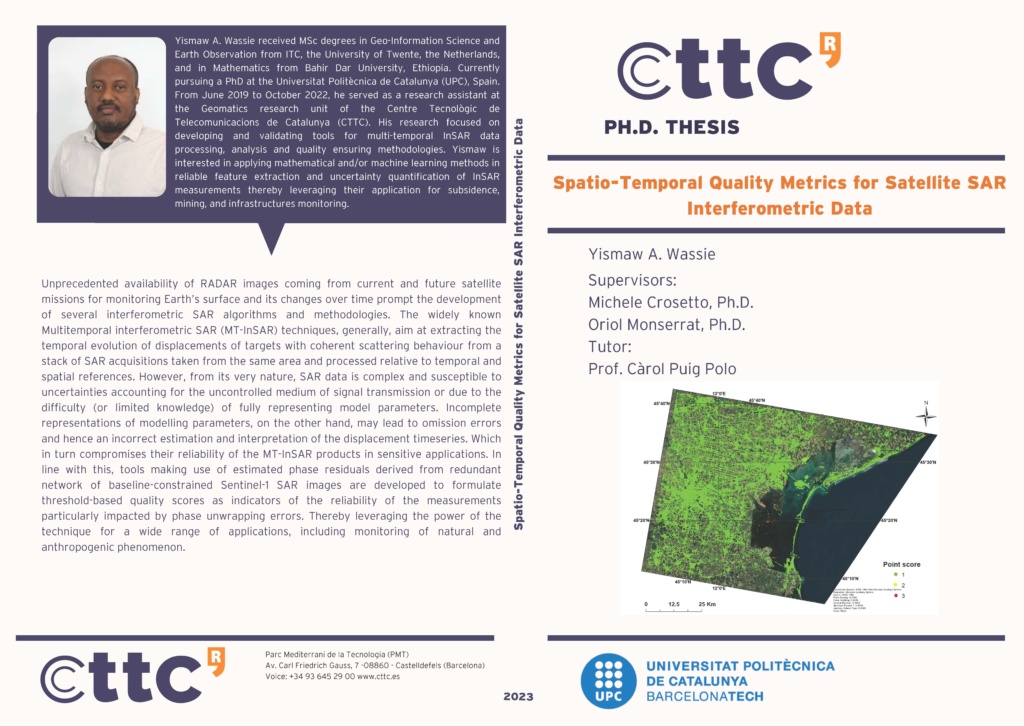
Spatio-Temporal Quality Metrics for Satellite SARInterferometric Data
Author/Autor: Dr. Yismaw A. Wassie
Year/Any: 2023
ABSTRACT
Unprecedented availability of RADAR images coming from current and future satellite missions for monitoring Earth’s surface and its changes over time prompt the development of several interferometric SAR algorithms and methodologies. The widely known Multitemporal interferometric SAR (MT-InSAR) techniques, generally, aim at extracting the temporal evolution of displacements of targets with coherent scattering behaviour from a stack of SAR acquisitions taken from the same area and processed relative to temporal and spatial references.
However, from its very nature, SAR data is complex and susceptible to uncertainties accounting for the uncontrolled medium of signal transmission or due to the difficulty (or limited knowledge) of fully representing model parameters. Incomplete representations of modelling parameters, on the other hand, may lead to omission errors and hence an incorrect estimation and interpretation of the displacement time series. Which in turn compromises their reliability of the MT-InSAR products in sensitive applications. Inline with this, tools making use of estimated phase residuals derived from redundant network of baseline-constrained Sentinel-1 SAR images are developed to formulate threshold-based quality scores as indicators of the reliability of the measurements particularly impacted by phase unwrapping errors. Thereby leveraging the power of the technique for a wide range of applications, including monitoring of natural and anthropogenic phenomenon.
RESUM
La disponibilitat sense precedents d’imatges RADAR procedents de missions de satèl·lit actuals i futures per monitoritzar la superfície de la Terra i els seus canvis al llarg del temps impulsa el desenvolupament de diversos algorismes i metodologies SAR interferomètriques. Les tècniques SAR interferomètriques multitemporals (MT-InSAR), generalment, tenen com a objectiu extreure l’evolució temporal dels desplaçaments de dianes amb comportament de dispersió coherent a partir d’una pila d’adquisicions SAR preses de la mateixa àrea i processades en relació amb referències temporals i espacials.
No obstant això, per la seva pròpia naturalesa, les dades SAR són complexes i susceptibles a incerteses que expliquen el mitjà incontrolat de transmissió del senyal o a causa de la dificultat (o coneixement limitat) de representar completament els paràmetres del model. Les representacions incompletes dels paràmetres de modelització, d’altra banda, poden conduir a errors d’omissió i, per tant, a una estimació i interpretació incorrectes de les sèries temporals de desplaçament. El que al seu torn compromet la fiabilitat dels productes MT-InSAR en aplicacions sensibles.
En línia amb això, es desenvolupen eines que utilitzen residus de fase estimats derivats d’una xarxa redundant d’imatges SAR Sentinel-1 amb restriccions de base per formular puntuacions de qualitat basades en llindars com a indicadors de la fiabilitat de les mesures particularment afectades pels errors de desembolic de fase. Aprofitant així el poder de la tècnica per a una àmplia gamma d’aplicacions, inclòs el seguiment de fenòmens naturals i antropogènics.
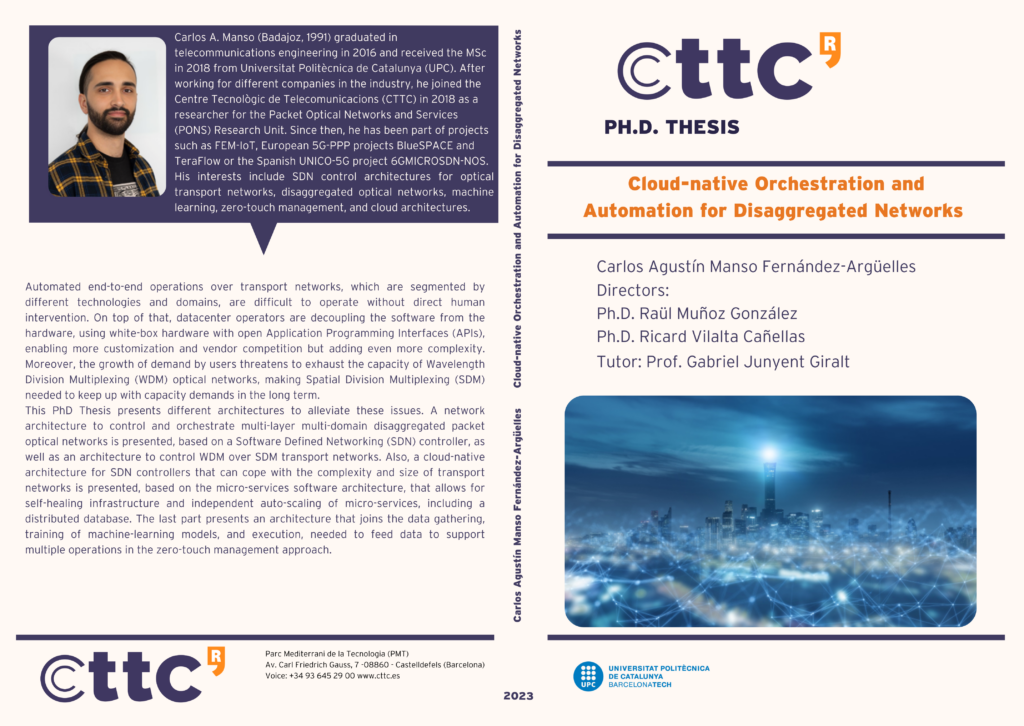
Cloud-Native Orchestration and Automation for Disaggregated Networks
Author/Autor: Dr. Carlos Agustín Manso Fernández-Argüelles
Year/Any: 2023
ABSTRACT
Automated end-to-end operations over transport networks, which are segmented by different technologies and domains, are difficult to operate without direct human intervention. On top of that, datacenter operators are decoupling the software from the hardware, using white-box hardware with open Application Programming Interfaces (APIs), enabling more customization and vendor competition but adding even more complexity. Moreover, the growth of demand by users threatens to exhaust the capacity of Wavelength Division Multiplexing (WDM) optical networks, making Spatial Division Multiplexing (SDM) needed to keep up with capacity demands in the long term.
This PhD Thesis presents different architectures to alleviate these issues. A network architecture to control and orchestrate multi-layer multi-domain disaggregated packet optical networks is presented, based on a Software Defined Networking (SDN) controller, as well as an architecture to control WDM over SDM transport networks. Also, a cloud-native architecture for SDN controllers that can cope with the complexity and size of transport networks is presented, based on the micro-services software architecture, that allows for self-healing infrastructure and independent auto-scaling of micro-services, including a distributed database. The last part presents an architecture that joins the data gathering, training of machine-learning models, and execution, needed to feed data to support multiple operations in the zero-touch management approach.
RESUM
Les xarxes de transport estan segmentades per diferents tecnologies i dominis, cosa que dificulta les operacions automatitzades d’extrem a extrem i fa necessària la intervenció humana directa per desplegar plenament els serveis de connectivitat. A més, els operadors de centres de dades estan aconseguint una major eficiència i una reducció de costos desacoblant el programari del maquinari, utilitzant maquinari ”white-box” amb interfícies de programació d’aplicacions (API) obertes, cosa que permet una major personalització i competència entre proveïdors. D’aquesta manera, es pot construir un sistema òptic a partir de components de diferents proveïdors, en lloc de sistemes òptics no interoperables d’un únic proveïdor.
Encara no hi ha models de dades estàndard clars (independents del proveïdor) que descriguin les capacitats, atributs, operacions i notificacions dels dispositius, ni protocols de transport eficients que proporcionin primitives per visualitzar i manipular les dades. A més, el creixement de la capacitat oferta pels operadors, en reacció a la demanda dels usuaris, amenaça d’esgotar la capacitat de les xarxes òptiques de multiplexació per divisió de longitud d’ona (WDM). Ampliar l’espectre d’ús pot ser una solució a curt termini, però a llarg termini caldrà desplegar la multiplexació per divisió espacial (SDM) per mantenir el ritme de la demanda de capacitat. En resum, no hi ha una arquitectura de control clara per aprofitar plenament aquestes tecnologies de forma conjunta.
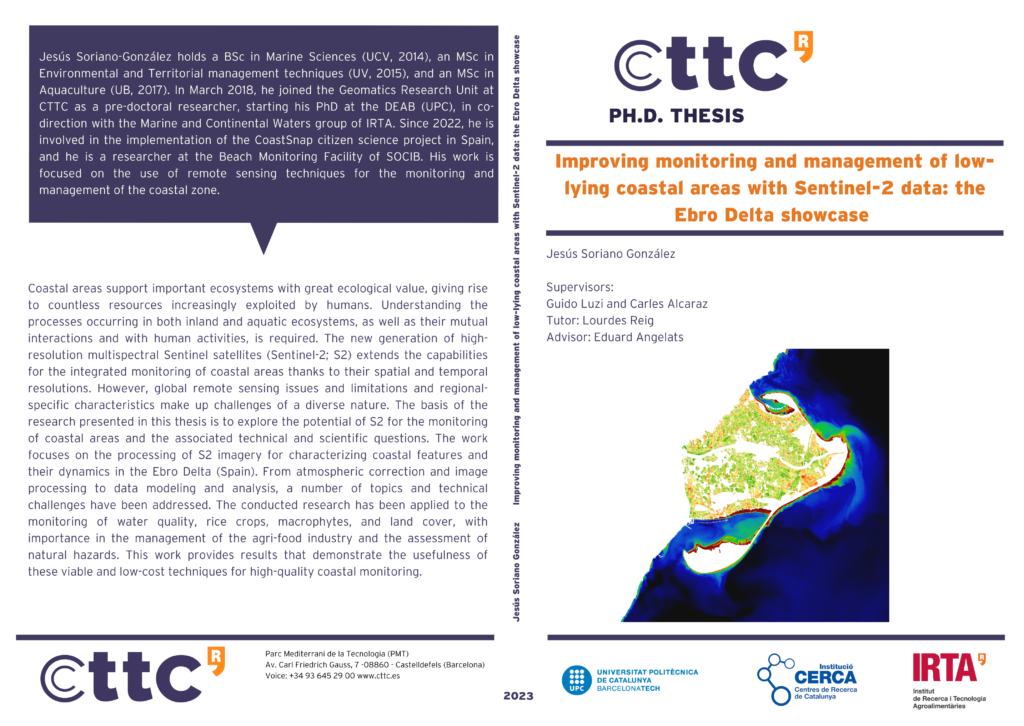
Improving Monitoring and Management of Low-lying Coastal Areas with Sentinel-2 Data: the Ebro Delta Showcase
Author/Autor: Dr. Jesus Soriano González
Year/Any: 2023
ABSTRACT
Coastal areas support important ecosystems with great ecological value, giving rise to countless resources increasingly exploited by humans. Understanding the processes occurring in both inland and aquatic ecosystems, as well as their mutual interactions, and with anthropic activities is required. In this line, the new generation of high-resolution multispectral Sentinel satellites (Sentinel-2; S2) extend the capabilities for the integrated monitoring of coastal areas thanks to their spatial and temporal resolutions (up to 10 m and 5 days). However, global remote sensing issues/limitations (e.g., cloud screening, spectral mixing, atmospheric correction) and regional-specific characteristics (e.g., involved ecosystems, economic fabric, interlinkages), make up challenges of diverse nature. The basis of the research presented in this thesis is to explore the potential of S2 for the monitoring of coastal areas, and the associated technical and scientific questions.
The work is focused on the processing of S2 imagery for characterizing Ebro Delta (Spain) coastal features and their dynamics. From atmospheric correction and image pre-processing to data modelling and analysis, a number of technical and scientific challenges have been addressed. The conducted research has been applied to the estimation of phytoplankton biomass at coastal bays (aquaculture), the generation of information on crop dynamics and management (agriculture), the assessment of agriculture runoff disturbance in coastal waters (environmental monitoring), and the characterization of storms’ effects on land and water ecosystems (natural hazards). A work that brings the application of satellite image processing to scientists, engineers, coastal managers, and stakeholders by providing results that demonstrate the usefulness of these viable and low-cost techniques for high-quality coastal monitoring.
RESUM
Les zones costaneres alberguen importants ecosistemes de gran valor ecològic, que donen lloc a innumerables recursos cada cop més explotats per l’ésser humà. Per això, és necessari comprendre els processos que ocorren tant en els ecosistemes terrestres com en els aquàtics, així com les seves interaccions mútues i amb les activitats antròpiques. En aquesta línia, la nova generació de satèl·lits multiespectrals Sentinel d’alta resolució (Sentinel-2; S2) amplia les capacitats per a la monitorització integrada de les zones costaneres gràcies a les seves resolucions temporals i espacials millorades (fins 10 m i 5 dies). Tanmateix, els problemes/limitacions globals de la teledetecció (ex., triatge de núvols, barreja espectral, correcció atmosfèrica) i les característiques específiques de cada regió (ex., ecosistemes implicats, teixit econòmic del lloc, interrelacions), composen reptes de diversa naturalesa. En aquest sentit, la base de la investigació presentada en aquesta tesi és explorar el potencial de
S2 per a la monitorització de zones costaneres, i les qüestions tècniques i científiques associades. El treball es centra en el processat d’imatges S2 per a la caracterització d’aspectes costaners al Delta de l’Ebre (Espanya) i la seva dinàmica, involucrant l’aqüicultura, l’agricultura, la planificació espacial, el seguiment mediambiental, i la preparació front a riscos naturals.
Des de la correcció atmosfèrica i el pre-processat de les imatges (primers passos) fins el modelat i l’anàlisi de les dades (últims passos), s’han abordat diferents reptes tècnics i científics. En aigües costaneres, s’han utilitzat diferents nivells de correcció atmosfèrica, processadors, combinacions espectrals i models estadístics per a cartografiar la qualitat de l’aigua (i.e., clorofil·la-a, profunditat del disc de Secchi) i els macròfits (i.e., praderes marines, macroalgues). Per estimar la clorofil·la-a (indicador de biomassa fitoplanctònica), els millors resultats es van obtenir utilitzant ratis simples entre les bandes visibles i/o del marge vermell aplicats a imatges corregides per Rayleigh o amb correcció atmosfèrica complerta, amb un ajust linial o polinomial de 2n grau (MAE ~ 0,6 mg/m3), obtenint series temporals que van permetre relacionar la distribució del fitoplàncton amb el forçament ambiental i antròpic.
La relació entre la profunditat del disc de Secchi i els productes d’atenuació de la llum (r > 0.75) va demostrar la viabilitat de la monitorització de la claredat de l’aigua amb S2. En quan a l’estimació de la cobertura de macròfits, la classificació supervisada per aprenentatge automàtic de composicions de bandes VIS-NIR de S2 va ser útil per avaluar la cobertura espacial de las comunitats de praderes marines i macroalgues en aigües poc profundes, revelant un impacte negatiu de l’escorrentia agrícola en comunitats de macròfits. A l’interior, es va desenvolupar un mètode automàtic basat en la identificació de punts clau en els perfils temporals combinats de tres índex comuns de vegetació i aigua superficial de la terra per a la extracció de mètriques fenològiques de l’arròs, la gestió de la irrigació i l’aproximació al rendiment dels cultius. Els resultats van proporcionar informació significativa sobre les etapes fenològiques de l’arròs i l’estat del camp (ex., maduresa de l’arròs, hidroperíode), mostrant també que el rendiment del cultiu s’estima millor durant el període de floració de l’arròs (r = – 0.8). Per últim, per avaluar els efectes de les tempestes amb S2, es va definir e implementar un mètode combinat de monitorització de la qualitat de l’aigua i les inundacions, reafirmant les grans capacitats de S2 per a representar els diferents graus de resiliència dels entorns terrestres i aquàtics. Aquesta investigació s’ha aplicat a l’estimació de la biomassa del fitoplàncton en badies costaneres (aqüicultura), a la generació d’informació sobre la dinàmica i gestió dels cultius (agricultura), a l’avaluació de les alteracions de l’escorrentia agrícola en el medi marí (vigilància ambiental) i a la caracterització dels efectes de les tempestes en ecosistemes terrestres i aquàtics (riscos naturals). Un treball que apropa les aplicacions del processat d’ imatges de satèl·lit a científics, enginyers, gestors costaners i parts interessades, proporcionant resultats que demostren la utilitat d’aquestes tècniques viables i de baix cost per a la monitorització costanera d’alta qualitat.
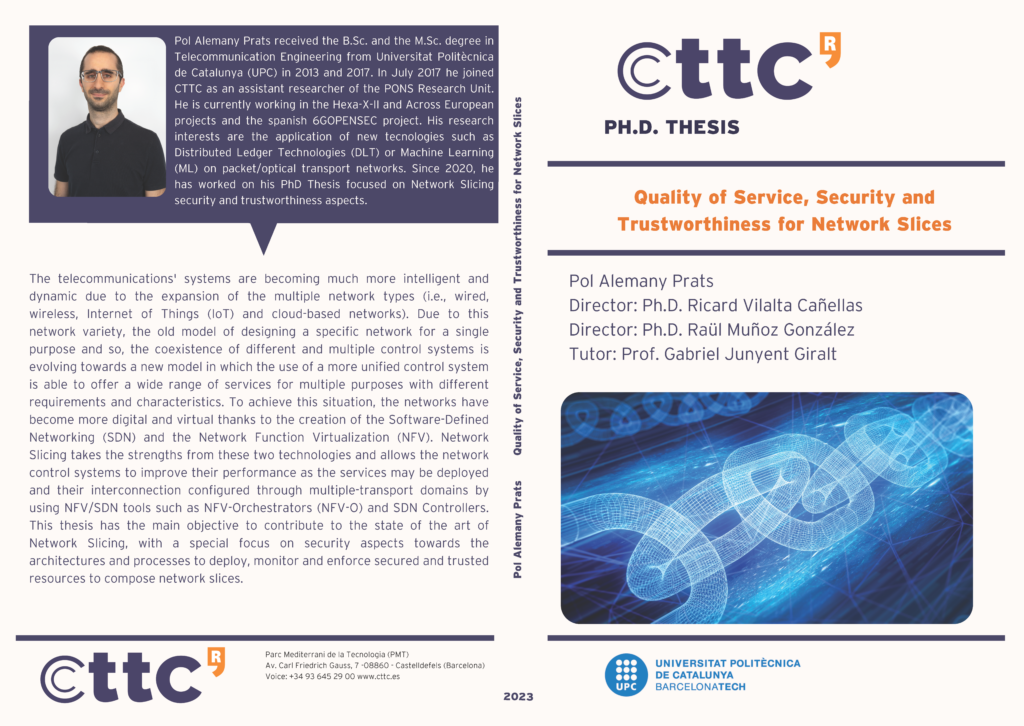
Quality of Service, Security and Trustworthiness for Network Slices
Author/Autor: Dr. Pol Alemany Prats
Year/Any: 2023
ABSTRACT
The telecommunications’ systems are becoming much more intelligent and dynamic due to the expansion of the multiple network types (i.e., wired, wireless, Internet of Things (IoT) and cloud-based networks). Due to this network variety, the old model of designing a specific network for a single purpose and so, the coexistence of different and multiple control systems is evolving towards a new model in which the use of a more unified control system is able to offer a wide range of services for multiple purposes with different requirements and characteristics.
To achieve this situation, the networks have become more digital and virtual thanks to the creation of the Software-Defined Networking (SDN) and the Network Function Virtualization (NFV). Network Slicing takes the strengths from these two technologies and allows the network control systems to improve their performance as the services may be deployed and their interconnection configured through multiple-transport domains by using NFV/SDN tools such as NFV-Orchestrators (NFV-O) and SDN Controllers. This thesis has the main objective to contribute to the state of the art of Network Slicing, with a special focus on security aspects towards the architectures and processes to deploy, monitor and enforce secured and trusted resources to compose network slices.
RESUM
Els sistemes de telecomunicacions s’estan tornant molt més intel·ligents i dinàmics degut a l’expansió de les múltiples classes de xarxes (i.e., xarxes amb i sense fils, Internet of Things (IoT) i xarxes basades al núvol). Tenint en consideració aquesta varietat d’escenaris, el model antic de disseny d’una xarxa enfocada a una única finalitat i, per tant, la una coexistència de varis i diferents sistemes de control està evolucionant cap a un nou model en el qual es busca unificar el control cap a un sistema més unificat capaç d’oferir una amplia gama de serveis amb diferents finalitats, requeriments i caràcter ístiques. Per assolir aquesta nova situació, les xarxes han hagut de canviar i convertir-se en un element més digitalitzat i virtualitzat degut a la creació de xarxes definides per software i la virtualització de les funcions de xarxa (amb anglès Software-Defined Networking (SDN) i Network Function Virtualization (NFV), respectivament).
Network Slicing fa ús dels punts forts de les dues tecnologies anteriors (SDN i NFV) i permet als sistemes de control de xarxes millorar el seu rendiment ja que els serveis poden ser desaplegats i la seva interconnexió a través de múltiples dominis de transport configurada fent servir eines NFV/SDN com per exemple orquestradors NFV (NFV-O) i controladors SDN.
Aquesta tesi té com a objectiu principal, contribuir en diferents aspectes a la literatura actual al voltant de les network slices. Més concretament, el focus és en aspectes de seguretat de cara a les arquitectures i processos necessaris per desplegar, monitoritzar i aplicar recursos segurs i fiables per generar network slices.
